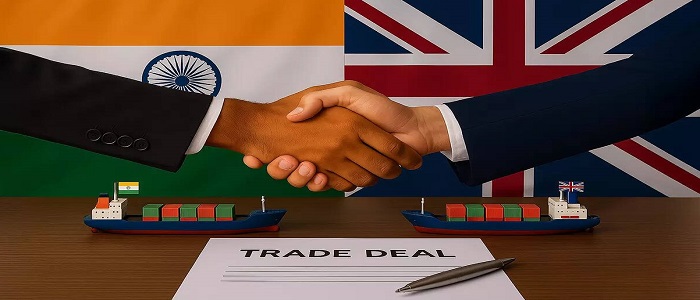Introduction
The India-UK Free Trade Agreement (FTA), officially termed as the India-UK Comprehensive Economic Partnership Agreement (CEPA), marks a significant milestone in India’s evolving global trade architecture. With negotiations launched in January 2022 finally signed on 24th July 2025, the FTA aims to create a liberal, equitable, and mutually beneficial trade framework between two major economies.

Advantages for India
a. Goods Sector — Export Expansion
- Tariff Elimination: Tariffs on approximately 99% of Indian exports to the UK will be removed, covering key categories such as textiles, leather, jewellery, seafood, pharmaceuticals, processed foods, auto components and chemicals.
- Export Growth: Trade is set to rise dramatically, with bilateral trade expected to reach US $120 billion by 2030, up from US $20–23 billion in 2024.
b. Services and Mobility
- Simplified Access: UK firms offering services in telecom, construction and digital sectors can operate in India without establishing local offices—India gains reciprocal mobility access for its professionals.
- Visa Flexibility: India secured 1,800 mobility visas for professionals in fields such as education, culture and corporate transfers. These include extended national insurance exemptions for intra-company transferees.
c. Pharma Safeguards
- Generics Protection: The FTA explicitly excludes requirements for patent term extensions or data exclusivity, preserving the generic pharmaceutical industry’s ability to compete and ensuring access to affordable medicine.
d. Strategic Investment and Jobs
- Foreign Investment: Enabled investment deals are expected to bring nearly £6 billion in new investment and export wins, supporting sectors such as aerospace, technology and advanced manufacturing.
- Supply-Chain Strengthening: Companies in manufacturing, logistics and IT services can scale operations in both countries, reinforcing India’s position in global value chains.
3. Rule of Origin: Ensuring Genuine Bilateral Trade
A key chapter in the India–UK FTA is the Rules of Origin (RoO) provisions, which define the economic nationality of a product. These rules determine whether goods qualify for tariff concessions under the agreement.
Legal Reference
- The RoO provisions in the India–UK FTA are modeled in line with the WTO Agreement on Rules of Origin
- The legal implementation in India is through the Customs (Administration of Rules of Origin under Trade Agreements) Rules, 2020 (CAROTAR 2020), notified under Section 156 of the Customs Act, 1962.
Qualifying Value Content
The party is required to fulfil the Qualifying Value Content condition along with Change in tariff heading/subheading. QVC shall be calculated as below:
a. Build-Down Method: based on the value of non-originating materials
QVC= value of the good-value of non‐originating materials/ value of the good ×100
b. Build-Up Method: based on the value of originating materials
QVC= value of originating materials/ value of the good ×100 where,
QVC is the qualifying value content of a good, expressed as a percentage.
Standard QVC criteria:
- 40 percent of the ex-works price under the build-down method;
- 45 percent of the free-on-board value under the build-down method; or
- 35 percent of either the ex-works price or free-on-board value under the build-up method;
Conclusion
The India–UK FTA, signed on 24 July 2025, marks a historic turning point in India’s trade strategy. Backed by WTO rules and Indian law, it opens markets, supports strategic sectors, and upholds India’s policy priorities. As the country gears up for ratification and implementation, Indian exporters, service providers, and investors can leverage this agreement to grow, diversify, and deepen global partnerships.





